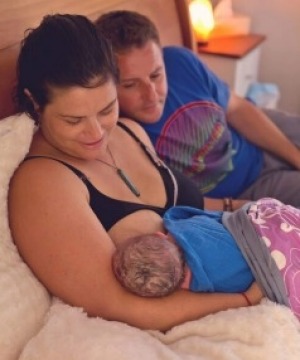
A black and white image of a newborn baby next to his placenta draws attention to the sacred link between the organ and the land.
The photograph, posted on Emma Jean Photography's Facebook page, shows an unclothed Harper Hoani Spies 90 minutes after he was born at 3.53am on January 2.
Harper was born at his Brisbane home to Jolene Spies, from New Zealand, and dad Johann Spies, from South Africa.

In the image, the baby boy is still attached to his placenta – the organ which nourishes a fetus in utero.
The umbilical cord spells out the word "love".
The post explains the traditional Maori custom of burying the placenta: "Whenua (placenta) is returned to the whenua (land) with the pito (umbilical cord) the link between the newborn and papatuanuku (mother earth)."

"With this affinity established, each individual fulfils the role of curator, for papatuanuku (mother earth), which remains life long."
Welcome earthside sweet little HarperAs a Maori baby his placenta will now be returned to the land. The word 'whenua'...
Posted by Emma Jean Photography on Saturday, 2 January 2016
Photographer Emma Jean Nolan told Stuff she took the photograph as a surprise for Harper's parents.
"I set it up while she was showering and sent it to her later that day," Nolan said.
"They were very excited and happy with the image and asked if I would share it on my [Facebook] page."
Jolene Spies, who is a homeopath and doula of Ngai Tahu descent, said it was "the perfect photo signifying what's important for me".
She said while her husband loved the photo, he was "a little bit squeamish".
Despite being a trained midwife, Nolan was not working in that capacity for the Spies family.
"I was simply a birth photographer," she said.
Jolene Spies, who moved with her family to Brisbane from Auckland a year ago, met Nolan in the birthing community.
The pair became good friends, and Nolan was present when Jolene took the pregnancy test.
"The first thing I said to her, after being a little bit shocked, was, 'Great, can you photograph the birth?'"
Jolene said when her third baby was born, there were no photographs taken.
"It wasn't until afterwards I sort of realised no one had taken any photos, and I thought it was really sad."
Nolan, who works part time as a midwife and part time as a photographer, shared image on social media to raise awareness of a "beautiful and sacred" but little-known cultural practice.
Nolan, who is not of Maori descent, said a common response from Australians when asked if they would like to take their placenta home was: "Why on earth would I want to do that?"
"Some people worry that by burying it it will attract animals into the yard to dig it up."
The story has been picked up by international media. The significance of the occasion was apparently lost on some outlets.
New York Magazine ran the story in its "DIY" section with this headline: "Fun Words to Spell With Your Baby's Umbilical Cord."
Nolan is philosophical about the mixed reactions she has encountered.
"There will always be people who will be shocked or 'disgusted' by the sight of the placenta, and that's okay," she said.
"But many people can see the beauty in the image of the connection to life. The placenta may not be beautiful in appearance but it is beautiful in its existence and its work.
"We all owe our life to a placenta."
The Spies, who have three other children aged 2-8 years old, have buried the placentas of all but one of the births.
"We don't do a big ceremony but they've all got their own little stories about where they were buried and why they were buried there."
Harper's placenta will be buried under a native totara tree on his grandfather's farm in the Bombay Hills of Auckland.
Jolene's father will collect the placenta and fly back to New Zealand with it in a few weeks' time.